 go to NIMS Superalloy home
go to NIMS Superalloy home
DESIGN AND DEVELOPMENT OF NI-BASE SINGLE-CRYSTAL SUPERALLOYS
ON ATOMIC BASIS
COMPARISON BETWEEN APFIM ANALYSIS AND NUMERICAL ESTIMATES
Ni-base single crystal superalloys, which have remarkable properties at
elevated temperatures, have been designed for use as turbine blades in
aeroengines. In order to develop higher efficiency engines, there are still
considerable efforts being devoted to enhance the temperature capabilities of
superalloys. Common superalloys consist of g and g' phases, which have the
face-centred cubic and L12 structures, respectively. Since the nature and
interactions between these two phases to a large extent affect the properties
of Ni-base single crystal superalloys, understanding the atomic structure
of the g and g' phases is of the utmost importance in the development of novel alloys
with superior mechanical properties.
Atom probe field ion
microscope (APFIM) , which has spatial and chemical resolution at an
atomic level,
is an appropriate method for investigating the atomic structure of the
two phases.
Numerical methods have been proposed to predict the atomic structure and
mechanical properties of Ni-base superalloys. Our research group have
established an alloy design program (ADP), based on a semiemprical
rationalisation of available data [6-8].
It has a demonstrated ability to predict the
compositions of the g and g' phases, g / g' lattice misfits, creep rupture
life
etc. Using this method, we have developed several Ni-base superalloys with
superior mechanical properties at elevated temperatures [1-5]. TMS-63 and TMS-
71, the compositions of which are listed in table 1, are tintroduced in this
article.

As a more fundamental approach, we have also applied the cluster variation
method (CVM) to Ni-base superalloys. This method employs Leonard-Jones
pair potentials, and allows the equilibrium phase chemistries, volume
fractions and lattice parameters to be estimated as a function of alloy
composition, temperature and pressure. Some important factors affecting the
mechanical properties of nickel-base superalloys can be estimated with the
Two numerical methods described above. In FIG.1, the composition data of
TMS-63 obtained from CVM and ADP calculations are summarized and
compared against APFIM experiments. It is obvious that experiment and
theory compare well for all the alloys examined.
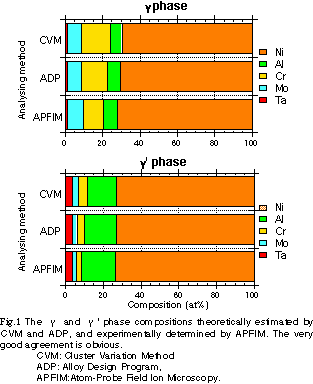
It is also important to investigate the site occupancy of alloying elements in
the g' phase since whether the alloying element prefers the Ni sites or the Al
sites drastically alters the g' volume fraction, eg. alloying elements which are
likely to substitute for the Al site increase the g' volume fraction whearas
those likely to substitute for the Ni site decrease the volume fraction. The
"layer-by-layer analysis" using APFIM makes it possible to experimentally
determine the substitution site of solute atoms in the g' phase. FIG.2 shows
the summarized site occupancy probabilites derived from APFIM analyses
and CVM calculations in the case of TMS-63.
The experimental results confirm that Ta and Mo prefer to substitute for
the Al
sites, while Cr prefers the Ni sites. These site occupation tendencies are
generally good agreement with theoretical prediction derived from CVM.
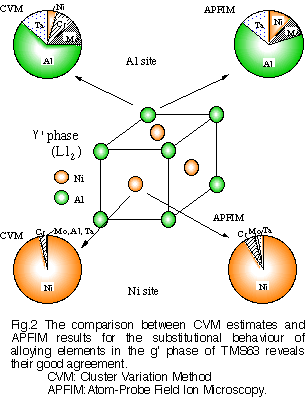
VARIATIONS IN LOCAL CHEMISTRY AT g / g' INTERFACES
Composition changes at the g / g' interfaces can be determined by APFIM
analysis. These interface analysis has been conducted for TMS-71 with
1300x4h~AC solution treated and 1100x1h~AC ageing heat treatments.
FIG. 3 is the typical example of the composition change at the
interface.
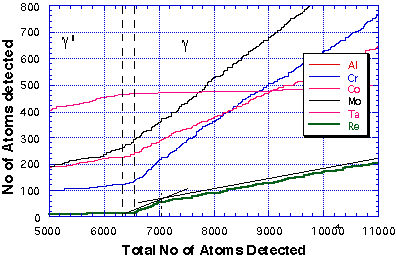
Fig. 3 Compositional changes at a g and g' interface , showing enrichment
of Re in the g phase adjacent to the interface.
Re enrichment of the g phase adjacent to the interface was observed, which can
be explained as in FIG.4.
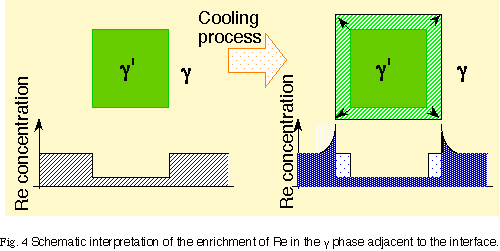
Under thermodynamically equilibrium condition, the
volume fraction of the g' phase is higher when temperature is low. It is thus
expected that the g' phase tends to increase in size during cooling process.
Since Re has strong preference to partition into g phase, Re atoms are
depleted from the g' phase. Because of its low mobility, Re atoms are likely
to enrich at the interface.
This tendency of Re may play a role in retarding the
coarsening of g' phase during cooling, which is advantageous for practical
heat treatment of the alloys.
FIG. 5 shows the temperature capability of alloys
as a function of lattice misfit. It is suggested in this figure that the temperature
capability can be improved by changing the lattice misfit towards negative
direction. However, if the lattice misfit is too large negative value, the
coherancy easily breaks down during heat treatment, or even during cooling
process. In practice, the alloy TMS-64 is still very sensitive to heat treatment
so as to maintain coherency although this alloy has demonstrated superior
temperature capabilities under optimum heat treatment procedures. It is thus
expected that TMS-71, which has slightly negative misfit at room
temperature, can be higher temperature capabilities than any orher alloy
existing and less sensitive to cooling process.
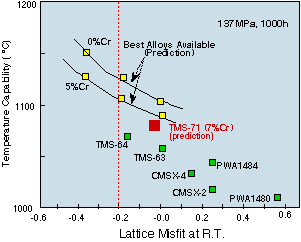
FIG.5 The predicted and experimentally observed temperature capabilities
of some Ni-base single crystal superalloy as a function of lattice misfit.
Re containing TMS-71 is a promising material with good mechanical properties
which are less sensitive to its thermal histroy.
REFERENCES
- H.Harada and M.Yamazaki, Tetsu to Hagane, 65, (1979) 1059.
- H.Harada, K.Ohno, T.Yamagata, T.Yokokawa and M.Yamazaki, Proc. of the 6th
International Symposium on superalloys, Seven Springs, (1988) 305.
- H.Harada, T.Yamagata, S.Nakazawa, K.Ohno and M.Yamazaki, Proc. of a
Conference "High Temperature Materials for Power Engineering 1990", held in
Liege, Belgium, (1990)1319.
- T.Yokokawa, K.Ohno, H.Harada, S.Nakazawa, T.Yamagata and M.Yamazaki,
Proc. of the 5th inter. conf. on Creep and Fracture of Engineering Materials and
Structures, Swansea, U.K,.(1993) 245.
- H.Harada, T.Yamagata, T.Yokokawa, K.Ohno and M.Yamazaki, Proc. of the 5th
inter. conf. on Creep and Fracture of Engineering Materials and Structures, Swansea,
U.K,.(1993) 255.
- M.Enomoto and H.Harada, Metall. Trans., 20A, (1989) 649.
- M.Enomoto, H.Harada and M.Yamazaki, CALPHAD, 15, (1991) 143.
- M.Enomoto, H.Harada and H.Murakami, Tetsu-to-Hagane, 80, (1994),
57.
PUBLICATIONS
- H.Harada, A.Ishida, H.Murakami, H.K.D.H.Bhadeshia and M.Yamazaki,
Atom-probe microanalysis of a nickel-base single crystal superalloy,
Appl. Surf. Sci., 67, (1993) 299.
- H.Murakami, H.Harada and H.K.D.H.Bhadeshia,
The location of atoms in Re- and V- containing multicomponent nickel-base single-
crystal superalloy,
Appl. Surf. Sci., 76/77 (1994) 177.
- H.Murakami, P.J.Warren and H.Harada,
Atom-probe microanalyses of some Ni-base single crystal superalloys,
Proc. of the 3rd Inter. Charles Parsons Turbine Conference, Newcastle upon Tyne,
(1995) 343.
Contact MURAKAMI.Hideyuki@nims.go.jp
Back to Parent Page
 go to NIMS Superalloy home
go to NIMS Superalloy home





